IBM-1 CALCULATIONS ON THE EVEN-EVEN 122
advertisement
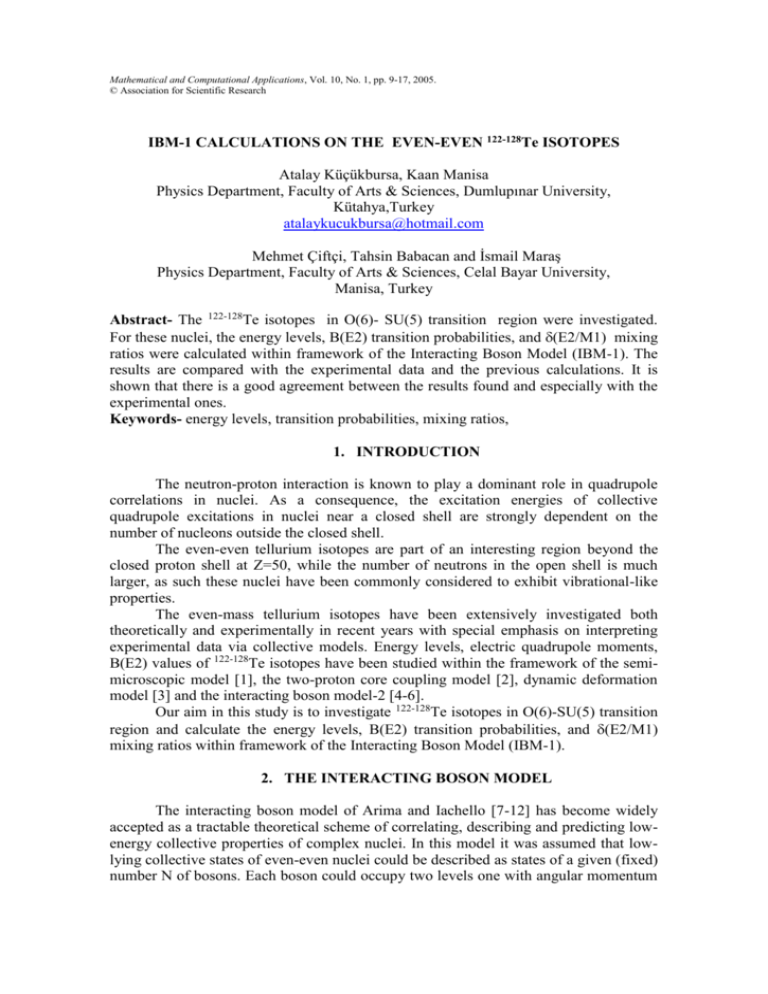
Mathematical and Computational Applications, Vol. 10, No. 1, pp. 9-17, 2005. © Association for Scientific Research IBM-1 CALCULATIONS ON THE EVEN-EVEN 122-128Te ISOTOPES Atalay Küçükbursa, Kaan Manisa Physics Department, Faculty of Arts & Sciences, Dumlupınar University, Kütahya,Turkey atalaykucukbursa@hotmail.com Mehmet Çiftçi, Tahsin Babacan and İsmail Maraş Physics Department, Faculty of Arts & Sciences, Celal Bayar University, Manisa, Turkey Abstract- The 122-128Te isotopes in O(6)- SU(5) transition region were investigated. For these nuclei, the energy levels, B(E2) transition probabilities, and (E2/M1) mixing ratios were calculated within framework of the Interacting Boson Model (IBM-1). The results are compared with the experimental data and the previous calculations. It is shown that there is a good agreement between the results found and especially with the experimental ones. Keywords- energy levels, transition probabilities, mixing ratios, 1. INTRODUCTION The neutron-proton interaction is known to play a dominant role in quadrupole correlations in nuclei. As a consequence, the excitation energies of collective quadrupole excitations in nuclei near a closed shell are strongly dependent on the number of nucleons outside the closed shell. The even-even tellurium isotopes are part of an interesting region beyond the closed proton shell at Z=50, while the number of neutrons in the open shell is much larger, as such these nuclei have been commonly considered to exhibit vibrational-like properties. The even-mass tellurium isotopes have been extensively investigated both theoretically and experimentally in recent years with special emphasis on interpreting experimental data via collective models. Energy levels, electric quadrupole moments, B(E2) values of 122-128Te isotopes have been studied within the framework of the semimicroscopic model [1], the two-proton core coupling model [2], dynamic deformation model [3] and the interacting boson model-2 [4-6]. Our aim in this study is to investigate 122-128Te isotopes in O(6)-SU(5) transition region and calculate the energy levels, B(E2) transition probabilities, and (E2/M1) mixing ratios within framework of the Interacting Boson Model (IBM-1). 2. THE INTERACTING BOSON MODEL The interacting boson model of Arima and Iachello [7-12] has become widely accepted as a tractable theoretical scheme of correlating, describing and predicting lowenergy collective properties of complex nuclei. In this model it was assumed that lowlying collective states of even-even nuclei could be described as states of a given (fixed) number N of bosons. Each boson could occupy two levels one with angular momentum 10 A. Küçükbursa, K. Manisa, M. Çiftçi, T. Babacan and İ. Maraş L=0 (s-boson) and another, usually with higher energy, with L=2 (d-boson). In the original form of the model known as IBM-1, proton- and neutron-boson degrees of freedom are not distinguished. The model has an inherent group structure, associated with it. In terms of s- and d-boson operators the most general IBM Hamiltonian can be expressed as [11] H ε s s † s d ( d †. d ) c L 0, 2, 4 L [(d †d†)(L).(dd)(L)]+1/2v0[(d†d† ) (00) s 2 +(s†)2 (dd ) (00) ] † † (2) + 1 / 2 v 2 [[( d d ) ds ](00) [ s†d† (dd)(2)] (00) 1 / 2u 0 (s†)2s2+ 1 / 5u 2 s†s(d†.d). (1) This Hamiltonian contains 2 one-body term, ( s and d ), and 7 two-body interactions [ c L (L=0,2,4), v L (L=0,2), u L (L=0,2)], where s and d are the single-boson energies, and c L , v L and u L describe the two-boson interactions. However, it turn out that for fixed boson number N, only one of the one-body terms and five of the two-body terms are independent, as it can be seen by noting N n s n d . (1) Hamiltonian can be rewritten in terms of the Casimir operators of U(6) group. In that case, one says that the Hamiltonian H has a dynamical symmetry. These symmetries are called SU(5) vibrational, SU(3) rotational and O(6) -unstable. The E2 transition operator must be a hermitian tensor of rank two and therefore the number of bosons must be conserved. Since, with these constraints there are two operators possible in the lowest order, the general E2 operator can be written as [13] Tm(E2)=2[s†d+ds)] (m2 ) +2[d†d] (m2 ) , (2) where 2 plays the role of the effective boson charge and 2 7 / 2 2 . The B(E2) strength for the E2 transitions is given by 2 B(E2;LiLf)=1/(2Li+1)1/2 L f Tm (E2) L i . (3) Similarly, the M1 operator would be just 1 [ d†d]1. To have M1 transitions, the IBM-1 rule must be extended to second-order in the U(6) generators [14]. The most general second-order M1 generator can then be written as T(M1) (g b AN )L B1[Q1L]1 B 2 [Q 2L]1 Cn d L . (4) Rather than attempting to evaluate the E2 and M1 matrix elements for 122-128Te isotopes essential in theoretical mixing ratio calculations, it is possible to obtain these ratios in an analytic form as the matrix element which has a simple structure in the O(6) and SU(5) limits. The calculated reduced E2/M1 mixing ratio [15] (E 2 / M1) n d , K, L T(E 2) n d 1, K , L n d , K, L T(M1) n d 1, K , L (5) 11 IBM-1 Calculations on the Even-Even 122-128Te Isotopes are related to mixing ratios, (E2 / M1) by δ(E 2 / M1) 0.835E γ (E 2 / M1) , (6) where E is called the transition energy and it is given in MeV and (E2 / M1) is in eb / n . 3. RESULTS AND DISCUSSION The computer program PHINT [16] was used to make the Hamiltonian diagonal. The best fit values for the Hamiltonian parameters are given in Table 1 and the calculated energy values which are compared with the experimental data [17-21] are given in Figs. 1-4 for 122-128Te isotopes. The agreement is good for member of ground state, and bands. Table 1. Hamiltonian parameters Isotopes 122 Te 124 Te 126 Te 128 Te EPS 0.500 0.570 0.611 0.611 PAIR 1.4 1.4 1.4 1.4 ELL -0.01 -0.01 -0.01 -0.01 QQ 0.001 0.010 0.020 0.020 OCT 0.00 -0.0050 0.0020 -0.0065 HEX 0.0099 0.0131 0.0038 0.0209 The calculated (E2 / M1) values are given in Table 2 together with experimental data [22-26]. It can be seen from the Table 2 that most of our results are in better agreement with those obtained experimentally. E2/M1 mixing ratios are compared with only experimental data; there exist no previous theoretical value for E2/M1 mixing ratios. The calculated values in this study show that the transitions connect the levels with the same parity and the E2 transitions are predominant. The later includes transitions originating from, and bands which supports the idea that the and bands may be quadrupole excitations of the perturbed ground state; but the existence of M1 the order of 10% indicates that the and bands can not be pure quadrupole excitations of the ground state band. Several E2 transition probabilities are experimentally investigated [27-31]. In Table 3, theoretical and experimental data are compared for proton charge e =2e. It can be seen from the Table 3 that theoretical B(E2) values agree with the experimental data within the indicated errors. The B(E2) values for the so-called cross-over 2 2 01 transition are well reproduced and they are very small. This shows that the particle and the collective contributions in the theoretical B(E2) values are out of phase. In the case of 2 2 21 transition B(E2) values are much larger when compared to the ones in 12 A. Küçükbursa, K. Manisa, M. Çiftçi, T. Babacan and İ. Maraş 2 2 01 transition. This is the inclusion of being both contributions in phase. A satisfactory comparison with the experiments is quite difficult due to the large errors on the experimental values, moreover the theoretical B(E2) values for that the transition seem to be systematically too small. This can be explained by the fact that many small components of the initial and final wave functions contribute coherently to the value of this reduced E2 transition probability. Since these small components are not stable enough against small changes in the model parameters, a quantitative comparison with the experimental data is not possible. Table 2. E2/M1 mixing ratios for 122-128Te isotopes Isotopes 122 124 126 128 Te Te Te Te Transition Energy E (keV) Spin Parity I i I f This Work (E2/M1) Experiment* (E2/M1) 692.6 2 2 21 1.04 -3.48 728.3 4 2 41 0.57 -0.57 694.3 2 3 21 1.04 ---- 1386.9 2 3 2 2 2.08 -0.3<<0.0 860.7 4 3 41 1.20 1.3 00..34 722.8 2 2 21 3.35 -3.55, -3.40 709.3 4 2 41 0.18 -0.18 -0.26 1436.5 2 3 21 1.27 1.5 00..63 713.7 2 3 2 2 1.54 0.52 0.10 0.23 753.9 2 2 21 4.80 -4.8, 4.25 00..15 01 1378.8 4 2 41 1.74 0.09<< 1.8 00..74 776.8 2 2 21 2.66 4.6 11..06 1225.3 2 3 21 4.20 4.2 12..00 531.0 3 3 41 1.24 1.4 643.6 3 3 2 2 1.84 0.45, 4.2 12..25 * Experimental values from Teixeira and Goldman (1993), Samuel et al. (1977), Hashizame et al. (1987), Kitao et al. (1986), Warr et al. (1998) IBM-1 Calculations on the Even-Even 122-128Te Isotopes 13 Table 3. B(E2) values for 122-128Te isotopes in e2b2 Isotopes 122 124 126 128 Te Te Te Te I i I f This Work Experiment* Previous Work* 21 01 0.13 2 2 21 0.23 2 2 01 0.01 0.1320.012 0.1300.020 0.130 0.350.16 0.350 0.00350.0017 0.0033 41 21 0.20 0.196 21 01 0.11 2 2 21 0.16 2 2 01 0.004 41 21 0.16 21 01 0.09 0.11380.0015 0.11400.0018 0.11500.0040 0.56860.2710 0.62200.3230 0.00450.0022 0.00500.0030 0.1630 0.144 0.2280 0.0940.004 0.10640.0010 2 2 21 0.14 0.126 0.170 2 2 01 0.00 0.008 41 21 0.16 0.159 21 01 0.07 2 2 21 0.04 0.0760.006 0.078 0.049 0.0858 0.1454 0.129 0.146 0.1128 0.0050 0.0038 0.003 0.198 0.1612 0.1145 0.1150 0.112 0.1598 0.57 0.0041 0.0044 0.1874 0.1581 0.164 0.091 0.102 0.139 0.117 0.118 0.178 0.001 0.0013 0.0006 0.1 0.131 0.1685 --- 2 2 01 0.00 --- 0.09 41 21 0.12 --- --- 0.130 * Experimental and previous theoretical values are taken from Lombard (1969), Lopac (1970), Degrieck and Berghe (1974), Samuel et al. (1977), Nagib et al. (1977), Robinson et al. (1983), Mardirosian and Stewart (1984), Subber et al. (1986), Rikovska et al. (1989), Subrahmanyeswara Rao, Bhaskara Rao (1990), Küçükbursa and Yörük (1999) 14 A. Küçükbursa, K. Manisa, M. Çiftçi, T. Babacan and İ. Maraş REFERENCES 1. V. Lopac, Semi-microscopic description of even tellurium isotopes, Nucl. Phys., A155, 513- 525, 1970. 2. E. Degrieck, G. V. Berghe, Structure and electromagnetic properties of the doubly even Te isotopes, Nucl. Phys., A231, 141-158, 1974. 3. A. Subber, W. D. Hamilton, P. Park and K. Kumar, An application of the dynamic deformation model to the tellurium isotopes, J. Phys G: Nucl. Phys., 13, 161-175, 1987. 4. M. Sambataro, A study of Cd and Te isotopes in the interacting boson approximation, Nucl. Phys., A380, 365-382, 1982. 5. J. Rikovska, N. J. Stone, W. B. Walkers, Dynamical symmetries in even-even Te nuclides, Phys. Rev., C36, 2162-2165, 1987. 6. A. Küçükbursa and A. Yörük, IBM-2 calculations on the some even-even tellurium isotopes, Bulletin of Pure and Applied Sciences, 18D, 177-184, 1999. 7. A. Arima and F. Iachello, Collective nuclear states as representations of a SU(6) group, Phys. Rev. Let., 35, 1069-1072, 1975. 8. A. Arima and F. Iachello, Interacting boson model collective nuclear states (the vibrational limit), Ann. Phys., 99, 253-317, 1976. 9. A. Arima and F. Iachello, Interacting boson model collective nuclear states (the rotational limit), Ann. Phys., 111, 201-238, 1978. 10. A. Arima and F. Iachello, New symmetry in sd boson model of nuclei: the group O(6), Phys. Rev. Let., 40, 385-387, 1978. 11. A. Arima and F. Iachello, Interacting boson model collective nuclear states (the O(6) limit), Ann. Phys., 123, 468-492, 1979. 12. A. Arima and F. Iachello, The interacting boson model, Ann. Rev. Nucl. Part. Sci., 31, 75-105, 1981. 13. F. Iachello, Group Theory and Nuclear Spectroscopy, in; Lecture Notes in Physics, Nuclear Spectroscopy, Springer, Berlin, 1981. 14. O. Scholten, F. Iachello and A. Arima, Interacting boson model collective nuclear states (the transition from SU(5) to SU(3)), Ann. Phys., 115, 325-360, 1978. 15. P. O. Lipas, P. Toivonen and E. Hammaren, IBA-1 calculations of E2/M1 mixing ratios, Nucl. Phys., A469, 348-368, 1987. 16. O. Scholten, Computer Program PHINT, 1979. 17. C. M. Lederer and V. Shirley, Tables of Isotopes, Wiley, New York, 1978. 18. B. F. Richard, Table of Isotopes, CD-ROM Edition, 1996. 19. C. S. Lee, C. A. Cizewski, D. A. Barker et. al., In-beam study of the level structure of 122Te, Nucl. Phys., A528, 381-394, 1991. 20. C. S. Lee, C. A. Cizewski, D. A. Barker et. al., Single-particle and collective excitations in 124Te, Nucl. Phys., A530, 58-74, 1991. 21. C. Doll, H. Lehmann, H. G. Börner, T. V. Egidy, Lifetime measurement in 124 Te, Nucl. Phys., A672, 3-20, 2000. 22. R. P. Teixeira and I. D. Goldman, Analysis of the sigh of E2/M1 multipole mixing ratio of transitions in the even Te isotopes, Phys. Rev., C48, 2101-2104, 1993. IBM-1 Calculations on the Even-Even 122-128Te Isotopes 15 23. M. Samuel, U. Smilansky, B. A. Watson, Measurements of nuclear deformation parameters from elastic and inelastic scattering of and 3He ions on Te isotopes, Nucl. Phys., A279, 210-222, 1977. 24. A. Hashizame, Y. Tendow and M. Ohshima, Nucl. Data Sheets, 52, (1987), 641 25. K. Kitao, M. Kanbe, Z. Matsumoto and T. Seo, Nucl. Data Sheets, 49, (1986), 315. 26. N. Warr, S. Drissi, P. E. Garret, J. Jolie, J. Kern, H. Lehmann, S. J. Mannanal, J. P. Vorlet, Nucl. Phys., A636, 379-418, 1998. 27. R. J. Lombard, Quasi-particle description of 2+ and 3+ states of doubly even spherical nuclei, Nucl. Phys., A114, 449-462, 1969. 28. G. Mordirosian and N. M. Stewart, Low-energy nuclear states in 124Te, Z. Phys., A315, 213-222, 1984. 29. I. M. Naqib, A. Christy, I. Hall, M. F. Nolan and D. J. Thomas, Quadrupole moments of the first 2+ states of doubly even nuclei in the Z=50 region, J. Phys G: Nucl. Phys., 3, 507-517, 1977. 30. S. J. Robinson, W. D. Hamilton and D. M. Snelling, Levels and transitions in 124 Te following thermal-neutron capture by 123Te and the decay of oriented 124 Sb, J. Phys G: Nucl. Phys., 9, 961-984, 1983. 31. S. Subrahmanyeswara Rao, K. Bhaskara Rao, Low-energy excited states in 124Te nucleus, Il Nuovo Cimento, 103, 803-822, 1990. 16 A. Küçükbursa, K. Manisa, M. Çiftçi, T. Babacan and İ. Maraş 4500 Exp. 4000 12 Exp. IBM 1 3500 3000 2500 2000 1500 8 6 4 0 3500 3000 2500 2 8 10 8 6 4 6 6 4 2 2 3+ 2 3+ 0 0 2 0 0 122 Fig.1. The experimental and theoretical energy levels for Te IBM 1 Exp. IBM 1 Exp. 10 10 8 2000 1500 8 2 IBM 1 10 12 4 1000 500 10 10 Exp. IBM 1 6 10 8 6 4 4 500 2 2 0 0 0 1000 8 6 Exp. 10 IBM 1 8 2 6 4 4 2 2 2 0 0 Fig.2. The experimental and theoretical energy levels for 124Te 17 IBM-1 Calculations on the Even-Even 122-128Te Isotopes 3500 Exp. IBM 1 Exp. IBM 1 Exp. 10 3000 6 10 6 8 2000 6 6 4 1500 6 8 2500 IBM 1 4 6 4 4 2 0 2 0 4 4 0 2 2 0 1000 2 2 0 0 500 0 Fig.3. The experimental and theoretical energy levels for 3500 IBM 1 Exp. Exp. IBM 1 Exp. 3000 126 Te IBM 1 2 2500 2000 1500 1000 6 4 6 4 2 2 0 0 4 2 4 2 2 500 0 Fig.4. The experimental and theoretical energy levels for 128 Te
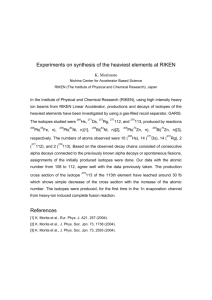
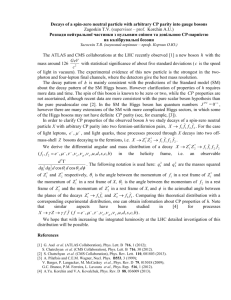
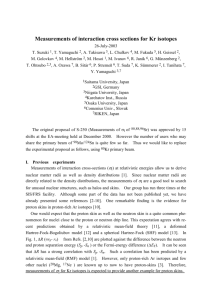
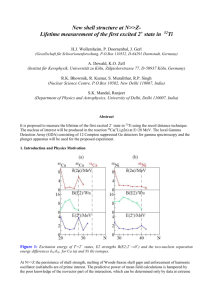


![paper_ed25_22[^]](http://s3.studylib.net/store/data/005874778_1-a76183b8bbb87cb1cdfe28832b638790-300x300.png)